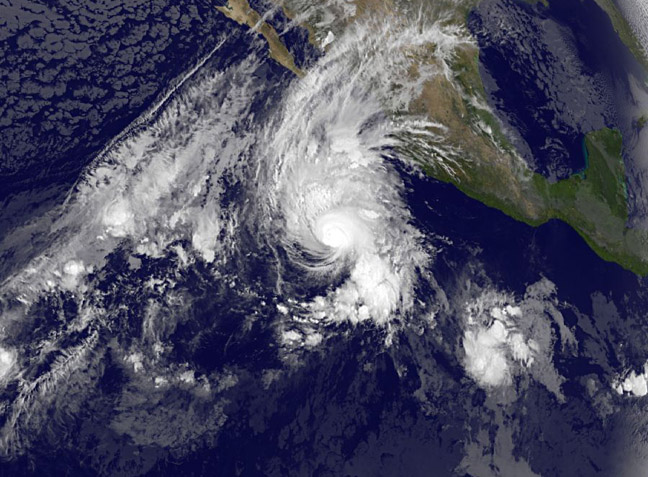Hurricane Vance Dwarfs Developing Low Pressure Area

NOAA's GOES-West satellite captured an image of Hurricane Vance and a developing low pressure area CALLED System 94E, southeast of the hurricane. Image Credit: NASA/NOAA GOES Project
NOAA's GOES-West satellite captured an infrared image of the Eastern Pacific that showed Hurricane Vance was a couple of times larger than the developing low pressure area known as System 94E to the southeast of the hurricane. In the GOES image, taken Nov. 3 at 1200 UTC (7 a.m. EST/4 a.m. PST) clouds and showers extending from Vance's northern quadrant stretched over northwestern Mexico.
At 7 a.m. PST, the center of Hurricane Vance was located near latitude 15.3 north and longitude 110.6 west. That puts Vance's center about 490 miles (785 km) west-southwest of Manzanillo, Mexico. Vance was moving toward the north-northwest near 12 mph (19 kph). Vance is expected to turn north then north-northeast by Nov. 4. Maximum sustained winds were near 105 mph (165 kph) and weakening is expected to begin today.
Moisture spreading northward ahead of Vance is expected to produce rainfall totals of 4 to 8 inches with Isolated amounts near 12 inches through Wednesday over the states of Sinaloa, Nayarit and Durango in western Mexico. Rough ocean swells are expected along the coast of southwestern Mexico and Baja California Sur tonight and Nov. 4.
Forecaster Brown at the National Hurricane Center (NHC) noted that “Recent microwave images show that the inner core of Vance remains vertically aligned (stacked on top of each other), however, the outflow is becoming increasingly restricted over the southwestern portion of the circulation due to southwesterly shear.” That vertical wind shear over Vance is forecast to dramatically increase during the next 24 to 48 hours which means that the storm is expected to weaken.
The NHC believes that Vance has peaked in intensity and will begin to rapidly weaken in the next couple of days as it curves to the coast near the border of Mexico and California.
Rob Gutro
NASA's Goddard Space Flight Center
Media Contact
All latest news from the category: Physics and Astronomy
This area deals with the fundamental laws and building blocks of nature and how they interact, the properties and the behavior of matter, and research into space and time and their structures.
innovations-report provides in-depth reports and articles on subjects such as astrophysics, laser technologies, nuclear, quantum, particle and solid-state physics, nanotechnologies, planetary research and findings (Mars, Venus) and developments related to the Hubble Telescope.
Newest articles

A ‘language’ for ML models to predict nanopore properties
A large number of 2D materials like graphene can have nanopores – small holes formed by missing atoms through which foreign substances can pass. The properties of these nanopores dictate many…

Clinically validated, wearable ultrasound patch
… for continuous blood pressure monitoring. A team of researchers at the University of California San Diego has developed a new and improved wearable ultrasound patch for continuous and noninvasive…

A new puzzle piece for string theory research
Dr. Ksenia Fedosova from the Cluster of Excellence Mathematics Münster, along with an international research team, has proven a conjecture in string theory that physicists had proposed regarding certain equations….



